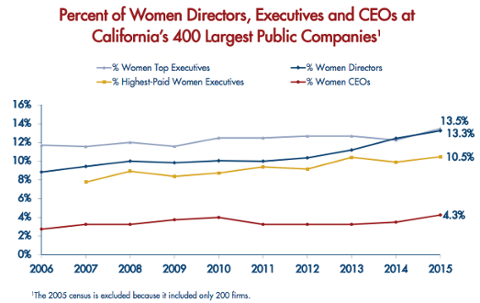When it comes to explaining gender disparity among their workforces, tech companies are often quick to point the finger at a broken pipeline. They’d love to hire more women, they claim. It’s just that the entry-level talent pool is still disproportionately male. Opinions differ as to whether or not that’s a valid excuse, but companies have a decidedly harder time explaining away the overwhelming lack of women in mid-level and senior-level roles. Women are not only paid less on average than their male counterparts, they are promoted less frequently to leadership positions. In fact, the disparity gets more pronounced the higher up the chain you go. While women make up almost 37 percent of tech workers at the entry level, that percentage drops to 30.5 percent at the managerial level and declines with each incremental career advancement, according to a workplace study conducted last year by McKinsey & Company and LeanIn.Org. The study found that women make up only 25.4 percent of tech workers at the director level and 20.2 percent of tech workers at the vice president level. By the time you get to senior executives, women make up just 18.7 percent. Zoom in to the startup sector, and the picture is even grimmer. A recent survey by Silicon Valley Bank found that 66 percent of tech startups had no women on their boards last year, and nearly half—46 percent—had no women executives at all. This despite the fact that more than a quarter of the survey’s respondents said their companies had programs designed specifically to increase the number of women in leadership positions. Something clearly isn’t working. Even with increased awareness of the issue over the last few years—including outreach programs to attract more women to STEM careers and tech giants such as Facebook and Microsoft claiming that they have closed the wage gap within their companies—the percentage of women in high-level tech careers remains persistently low. For those who have been working to counter gender disparity in tech, the statistics serve as a stubborn reminder of how much work still needs to be done. “I think we’d always hoped we would have seen more improvement by now,” said Kathryn Harris, president and longtime board member of Women in Technology (WIT), a nonprofit group near Washington, D.C. “When you think about how many women are coming through college—more women than men—you think it shouldn’t be so skewed at the top.” Harris said the effort to hire more women executives is not just a matter of doing the right thing; it’s also good for business. “The research shows that when there are women on boards you actually do better financially,” she added.
The Network Effect
Harris, a lawyer who formerly served as WIT’s general counsel, said the barriers preventing more women from advancing to leadership roles are varied and complex, whether it’s conscious or unconscious bias among hiring managers, lower retention rates for women employees, or inhospitable company cultures that discourage diverse points of view. Key to making companies more gender-inclusive is shifting perceptions at all levels of the tech industry ecosphere, she said, from the initial recruitment process to the venture capital firms that fund tech startups. There’s also the old adage about “who you know.” Personal and professional networks play a large role in career advancement, and when those networks are male-dominated, the boys’ club culture of boardrooms and C-suites becomes a self-perpetuating phenomenon. “You have mostly men who are running the venture capital firms and private equity firms,” Harris said. “They know other men. They reach out to their contacts. They don’t know a lot of women at those levels.” Harris added that WIT runs a program called the Leadership Foundry, which aims to prepare women to serve on corporate boards in the D.C. area, in part through networking and mentoring opportunities. Gloria Bell, co-founder of the Women in Tech Summit, a multi-city event that began in Philadelphia in 2011, also stressed the importance of networking, or rather what she called ‘intentional networking.’ “It’s not necessarily about the number of people you meet,” Bell said. “It’s about being intentional that you’re meeting the people who can help you in your career, and who you can help in their careers. That’s a skill that takes a lot to learn. It takes being very deliberate.”
An Ounce of Retention
Tech companies have been talking a good game about wanting to increase their ranks of women managers and executives, but that doesn’t mean just attracting more women—it means keeping them. Statistics show that women tend to leave the workforce at higher rates than men, and this is especially true in many tech-related careers. For instance, a three-year study from researchers at the University of Wisconsin-Milwaukee found that women make up 20 percent of engineer school graduates but comprise only 11 percent of working engineers. The survey’s 5,500-plus respondents had numerous reasons for leaving the profession, but often cited workplace culture or lack of advancement opportunities. “They feel like they’ve gone as far as they can go,” Bell noted. She added that it’s incumbent on tech companies to learn more about why women employees leave. “I think it’s important that they ask questions,” she said. “Why are they leaving? Is this something that we’ve created in our culture? Being aware of the causes gives companies opportunities to look at where they can make improvements to work on retention.” For women who leave their jobs temporarily to have children or spend more time with their families, re-entering the tech workforce can be equally difficult. Compounding this problem is the fast-moving nature of many sectors of the tech economy, where the tools of the trade advance at lightning speed. “Just look at cyber-security in the last five years,” Harris said. “It’s blown up into a huge industry segment, and even if you are in it every day and keeping up with it, it’s hard to keep track of it all. If you’re not staying involved when you take that mid-level career break, it’s tough getting back in.” Harris said she would like to see tech companies invest in reentry programs. She cited the OnRamp Fellowship, which helps women in the legal profession return to the workforce by connecting them with top firms. Some larger tech companies, for their part, have recently expanded their parental leave programs in an attempt to offer more flexibility. In April, Twitter said it would give all new parents 20 paid weeks off, following in the footsteps of companies such as Facebook and Netflix, as Bloomberg reported. But those are administrative answers to a problem that requires change at a much more systemic level. For all the strides women in tech have made in recent years, Harris said, career advancement can still feel like pushing through barriers, as opposed to being pulled up by those who have gotten there first. “It’s all about feeding the funnel and having role models,” Harris said. “Without a role model it’s tough to say, ‘Hey, I can do that.’ I think the same applies to mid-career women who want to succeed at the high levels.”



